
Wine Culture and Information since 2002 - Volume 22
 Wine Culture and Information since 2002 - Volume 22 |
|
Issue 53, June 2007 |
Contents |
|
|
The Culture of Moderation |
|
Every time the frequency of car accidents in which are involved the young increases, the most simple thing they think to do is to “blame” some habits and behaviors. One of the most frequent causes of car accidents, the statistics say, is about the consumption - but it should be better to say, the abuse - of alcohol. The problem is certainly serious, indeed, very serious. And every time the most simple thing they think to do in order to “fix” the problem is to repress some behaviors, while hoping such an extreme measure will be really useful to change things. Despite the many restrictive and punitive measures adopted, car accidents continue to happen, and there are people - not only the young - who after having excessively consumed alcoholic beverages, drive a car or a vehicle. Risks and consequences deriving from such behaviors are indisputably unacceptable, in particular for the consequences such behaviors causes to others, solely guilty of being in the wrong place at the wrong time. The problem is serious, of primary importance and something must certainly be done. However we should also think about the usefulness of “punitive” measures, and in particular, about the lack of proper cultural measures. The nature of human beings, as it is commonly known, is pretty “rebel”, and when something is forbidden, as soon as they have the chance, they break the rule, also for the simply - although stupid - satisfaction of doing something which is forbidden. It is something like in children, when their mother forbids them to do something, as soon as the mother is out of sight, no doubt about this, the kid exactly does what was forbidden to do. In this sense, kids and adults are the same, both confirming the nature of human beings. Although we fully agree, with no doubt, it is necessary to do something in order to avoid people drive a car after having drunk too much - as well as in case of the abuse of alcoholic beverages - we believe something else must be done as well, besides using punitive and repressive measures. Rules are certainly necessary: they contribute to the good keeping of social life while respecting common principles, respecting the others and, last but not the least, oneself. As long as society and institutions will limit themselves to solely repress some behaviors, without having the people to understand the reasons for which that rule exists, that rule is probably not very useful. As for the criteria used for the determination of “legal” consumption of alcoholic beverages, to set an objective limit is not very correct, as every subject has a personal capacity of metabolizing alcohol and the same quantity of alcohol consumed by different subjects does not give the same effects and behaviors. There are people who after having consumed one glass of wine show evident alterations in their behavior, whereas others, with the same quantity, are absolutely sober. Science and medicine teach us the capacity of metabolizing - or better to say, deteriorate - alcohol is done by an enzyme, alcohol dehydrogenase, found in different quantity in each one of us. Science has also proven women have a lesser quantity of this enzyme than men: this explains the reason why women usually have a lower tolerance towards the consumption of alcohol. In most of the countries, Blood Alcohol Content (BAC) - that is the quantity of grams of alcohol for every liter of blood - is set to 0.5, beyond this limit one is considered “legally” incapable for driving a vehicle. Rules are certainly necessary, of course, but as the physiology of every human being is different from the one of any other else, such a rule could be unsuitable for many, both because it could be too much or too little. However we have no intention in debating this law: what we think to be better is to find alternative solutions to this. Of course, law has the duty of making rules for the society in order to give a common reference to everyone and to make sure they are respected. However we think as long as they will just continue to trust the efficiency of such measures, people will continue to abuse alcoholic beverages and nothing will ever change, they will continue to count the dead of car accidents and to blame the disreputable behaviors of the ones who “drink too much”. We believe the problem must be faced differently. Alcohol is a toxic substance and this is indisputable, however its toxicity becomes evident in case it is consumed in high quantities, a quantity which is indisputably subjective for each one of us. Alcoholism and the abuse of alcohol certainly are two serious social and personal problems, also in those societies where the consumption of alcoholic beverages is socially accepted because part of the culture and tradition of that country, such as Italy. We believe, indeed, we are absolutely sure about this, the difference between moderation and abuse is uniquely represented by culture. As long as society and institutions will not understand the importance and value of awareness, of the spreading of the culture of moderation, by strongly criticizing certain social models which base their stupidity on the falsity of appearance - and only for the interest of few people - we think it is very hard to really change things. And this is something which must be done as soon as possible, also by beginning from the kids in the schools, not only by scolding adult people who already have their behaviors hard to change. The intelligent and moderate consumption of alcoholic beverage - including wine, of course - is a matter of culture: the conscious choice of those who appreciate in these beverages the pleasure expressed by senses, while respecting themselves and everything that beverage represents in culture, tradition and the expression of human talents and of nature. The abuse of alcoholic beverages certainly is a culture as well, something usually giving the uselessness of being lost somewhere else while hoping to find oneself different from what one feels or sees in real life. It is necessary to make understand the consequences of abuse, but also the pleasure and the richness - medicine suggests us there also are benefits for the health - an alcoholic beverage can give as long as it is respected and one respects oneself in moderation. As for us, we think we should do something for this problem by using our pages and our site. It will not be a determinant or essential contribution, however it probably is better than nothing. For this reason we thought about offering our readers a practical alcohol test in order to give an approximate measure according to law and to avoid any possible “bad surprise”. We wish this new service to be useful and appreciated like the other ones: it is our small contribution to wise drinking and to the culture of moderation. We remind our readers this “alcohol test” must be considered as a tool for the approximate evaluation of Blood Alcohol Content (BAC) only and the reliable determination is possible only by means of blood, breath and urine analysis. Moreover, our alcohol test is also available in DiWineTaste mobile - therefore it can be used from mobile phones - after having spent one night in company of friends and one wishes to have an approximate value of his or her Blood Alcohol Content. Cheers, but with moderation!
|
||||
MailBox |
|
In this column are published our reader's mail. If you have any comment or any
question or just want to express your opinion about wine, send your letters to
our editorial or fill in
the form available at
our site.
|
| There are many corkscrews available and all of them seem to be exceptional. Is corkscrew so important? After all it is just about uncorking a bottle! |
| Melanie Edwards -- Houston, Texas (USA) |
| Uncorking a bottle of wine, in its simplicity, is an operation to be done carefully, in particular in case of bottles containing a wine aged for many years. Cork is a natural material and with time it loses its elasticity and its mechanical qualities, therefore becoming fragile also because of the prolonged contact with wine. In these specific cases, the quality of corkscrew is important, and it is indispensable it will not damage the cork. A very important element of a corkscrew is the so called “spiral” - that is the part penetrating the cork - which must have a very low friction while facilitating the penetration in the cork without breaking it. An excellent solution is represented by spirals made of teflon. Also the grip and the lever point are very important because they allow the proper use of strength while avoiding excessive efforts, in particular with corks that, because of the effects of time, are stuck to the bottle's neck. Today are available many corkscrew models, from the classic and very effective “waiter's corkscrews” to technological solution allowing the extraction of cork from the bottle with no effort. When buying a corkscrew, particular attention must be paid in the quality of spiral, to its ergonomics and easiness of use, as well as its capability of keeping the cork intact during the extraction. |
| What is “Vin de Paille”? |
| Wayne Davidson -- Tullamore (Ireland) |
| “Vin de Paille” - literally Straw Wine - is a sweet wine produced in the French Jura and is the equivalent of vino passito produced in Italy. Grapes, after having harvested, are spread on a mat and allowed to dry in order to favor the loss of water, while allowing the concentration of sugar and juice. At the end of withering, grapes are crushed and it is obtained a thick and rich must, which will be then fermented. The result is a rich, sweet and concentrated wine. According to French classification of wines, Vin de Paille belongs to the category of Vin Liquoreux. |
LiguriaDespite it is one of the smallest regions of Italy, Liguria is a land rich in art, history, tradition and culture, in excellent wines kissed by the sea breeze |
|
Liguria certainly is one of the regions of Italy having among the most suggestive landscapes of the country, a characteristic which strongly influenced the enogastronomical culture of this land and, in particular, viticulture and wine making. A landscape having no in-between: the sea ahead - coasting the whole southern area of the region - and the mountains behind: two conditions which strongly influenced the gastronomic culture of the region. As it can be easily imagined, cooking in the areas coasting sea is almost exclusively based on fish, whereas in the internal areas the many products of earth and meat play the fundamental role in the table. This difference is also found in the wines of Liguria, where vineyards exposed to the sea breeze, most of the times cultivated in the slopes degrading down the sea, produce wines with an absolutely personal and particular “saltiness”, hardly found in wines produced somewhere else.
A land full of charm for many aspects, but also difficult because of its territory, not always easy to cultivate, in particular according to a viticultural point of view. Viticulture in Liguria can be in fact defined, in many areas of this region, as heroic. Most of the times, vineyards - in particular the ones in the “Cinque Terre” area - are cultivated in steep slopes, most of the times with no accessing road or paths, therefore the only way to get there is by feet. In these areas harvesting is strictly done by hand and the grape is transported outside the vineyard by grape-pickers by holding baskets on their shoulders. Despite this could be seen as romantic and charming, as a matter of fact, this is the only way - a forced way - to cultivate and harvest grapes in certain areas of Liguria. A lot of efforts and commitment are however rewarded by the result obtained in cellar, the wines, despite are produced in small quantities, are always distinguished in the Italian wine scene. The characteristics of Ligurian territory have strongly determined the development of viticulture and production of wine since the times of ancient Romans. Archaeological diggings done at Luni - the ancient Roman colony established in 177 BC and today belonging to the province of La Spezia, near the border with Tuscany - have however allowed the discovery of cups and amphoras, a sign the wine was present in the eastern area of Liguria since ancient times. The fact the production of wine was not practiced at the times of the establishment of Luni is witnessed by the historian Diodoro Siculo who in the first century BC wrote «in Liguria there are no olive trees and no vines, only woods… a land inaccessible to Ceres and Bacchus». Wine was however produced at the times of Strabonius - the famous Greek geographer who lived in the last years of the first century BC - who wrote in his book about geography «Ligurians consume milk and beverages made of barley, they buy at Genoa oil and wine and the small quantity of wine they make is resinous and sour». Ligurian enology seems to improve its quality and consideration with Pliny the Elder, who - in his monumental Naturalis Historia - writes «…the wines of Luni are the best ones in Etruria» and also Martial praised the wines produced in Liguria. There are no reliable and evident information on the exact period the vine was introduced in Liguria, many believe it was introduced by ancient Greeks, whereas other believe the cultivation of vine was practiced since the times of Etruscans. Reliable information on viticulture and production of wine in Liguria are dated back to the Middle Age, where written documents mention vineyards in the Riviera di Ponente, in the current territory of La Spezia and Cinque Terre. The importance of wine and viticulture will increase with the development and the prestige of Genoa: from the port of the powerful Repubblica Marinana were in fact shipped goods of any kind, including wine. The ampelography of Liguria was probably developed before the times of the Republic of Genoa, when sailors, coming back from their journeys, cultivated small areas of land in which they planted vine plants gathered during their journeys in the many places of the Mediterranean. The viticultural system adopted in Liguria - as a matter of fact, the only possibility offered by the territory - with its vertical vineyards, planted in the steep slopes degrading to the sea, have caught the interest and curiosity of many, also in past times. In particular Andrea Bacci - philosopher, doctor and historian who lived in the 1500s - mentioned in his book De Naturalis Vinorum Historia the suggestive vineyards of Cinque Terre, and wrote the grapes of this land «have a great value because of the roughness of the territory, because they are produced in limited quantities and lack of any excessive humidity». Andrea Bacci also mentioned two particular wines produced in the Cinque Terre, the precious amabile - produced with Albarola grape - and the more common razzese, both produced by interrupting the fermentation after few days, therefore poured in small barrels and loaded in ships: thanks to the effects of the movement caused by the sea during the journey, the wines improved and become better than they were before. A fundamental contribution to the history and the varieties found in Liguria and the wines produced in this region, was offered by the important book of count Giorgio Gallesio “La Pomona Italiana”, published at Pisa in 1817 and in which is found, for the first time, a detailed description of the grapes found in Liguria and completed by detailed color pictures. The work of count Gallesio is still today considered an essential reference book for the study of ampelographic and wine making history of Liguria. In La Pomona Italiana are widely mentioned Vermentino, Albarola (a grape called Bianchetta in Genoa) and the now rare Rossese Bianco. The production and development of viticulture in Liguria has been strongly determined by the environmental conditions and by the territory which, because of its characteristics, does not allow wide cultivations, indeed small and difficult. For this reason, still today the viticultural condition in Liguria, despite it is of excellent quality, it mainly made of small wineries and with pretty limited productions.
|
||||||||||||
|
The classification of wines in Liguria is regulated by the quality system in force in Italy with D.P.R. n° 930 of February 12th, 1963 and law 192 of 1992. The system provides four quality categories classified, from the lowest to the highest level, as Vini da Tavola (Table Wines), IGT (Indicazione Geografica Tipica, Typical Geographic Indication), DOC (Denominazione d'Origine Controllata, Denomination of Controlled Origin), DOCG (Denominazione d'Origine Controllata e Garantita, Denomination of Controlled and Guaranteed Origin) and, DOCG con indicazione di sottozona (DOCG with indication of subarea). In Liguria are currently defined 8 Denomination of Controlled Origin areas, whereas there are no DOCG areas. The DOC areas of Liguria are: Cinque Terre and Cinque Terre Sciacchetrà, Colli di Luni, Colline di Levanto, Golfo del Tigullio, Riviera Ligure di Ponente, Rossese di Dolceacqua or Dolceacqua Rossese, Val Polcevera - which includes the sub-denomination Val Polcevera Coronata - and Pornassio or Ormeasco di Pornassio.
|
|
In Liguria viticulture is practiced along the coast of the sea and in most of the internal areas of the region. In Liguria are mainly produced white wines, in particular in the central and eastern areas, whereas the production of red wine is lesser and mainly made in the western part of the region. The most important grape of Liguria certainly is Vermentino, found in most of the white wines, whereas the most common red grape of the region is Rossese, once defined as Nebbiolo of Liguria because of its low quantity of coloring substances - a characteristic also found in Piedmont's Nebbiolo of Langhe - and the capacity, in case it is vinified with quality criteria, of making good bodied wines. The main white berried grapes of Liguria are Vermentino, Pigato, Bosco and Albarola, whereas the main red berried grapes of the region are Rossese, Dolcetto - here known as Ormeasco - Ciliegiolo, Sangiovese and Barbera.
|
|
Cinque Terre takes its name from the five coastal towns along the Ligurian Sea, in the Eastern part of the region in the province of La Spezia. The wines of this Denominazione d'Origine Controllata are produced with the grapes cultivated near the cities of Monterosso, Vernazza, Corniglia, Manarolo and Riomaggiore. The viticultural landscape of Cinque Terre is among the most suggestive ones which can be observed: vineyards planted in steep slopes, in terraces degrading down to the sea. Harvesting is made difficult also because of the reduced access possibilities to vineyards, which can be reached only by narrow paths and therefore only by feet, the grapes, after the harvest, are loaded on the shoulders of grape-pickers and transported outside the vineyard. This harvesting method, despite is still in use in these areas, has been recently replaced in some vineyards with the introduction of rails on which run small carriages allowing an easier transport of grapes. The wines of Cinque Terre are produced with Bosco, Albarola and Vermentino grapes, from which are obtained dry wines and the special, as well as rare, Sciacchetrà. According to a viticultural point of view, the most representative town of Cinque Terre is Riomaggiore, where are defined the three sub areas of Costa de Campu, Costa dà Posa and Costa de Sèra. Dry white wines of Cinque Terre are medium bodied, characterized by a good crispness and a very personal saltiness given by the vicinity to the sea. The king of Cinque Terre is Sciacchetrà, a rare and excellent sweet wine produced with dried grapes. Sciacchetrà - locally and historically called rinforzato, or, in dialect, refursà - is produced with overripe grapes allowed to dry in aerated rooms, in order to favor the loss of water and the concentration of juice. The grape is then crushed and vinified, and at the end of fermentation, is obtained a sweet wine of rare elegance. Sciacchetrà must age for at least one year before commercialization, three years for the riserva style. Sciacchetrà represents one of the most rare sweet wines of Italy and, besides being magnificently consumed in meditation, is an excellent matching with desserts, in particular with almonds and dried fruits, or with piquant and hard cheese.
|
|
In the production of Ligurian wines - mainly made of white wines and grapes - are distinguished three red grapes and from which are produced interesting wines: Rossese, Ormeasco - name with which is called Dolcetto - and Ciliegiolo. In particular Rossese, a grape today considered autochthonous of Liguria but probably introduced from France, is the absolute protagonist of the wines of Dolceacqua. Called in the past Nebbiolo della Liguria, certainly not for a supposed genetic analogy with the famous grape of Langhe, Rossese produces red wines in which are mainly characterized aromas and flavors of wild berries and mild tannins. Ormeasco is mainly cultivated in the recent DOC area of Pornassio, where it also is produced, with the same grape, Ormeasco Sciac-trà, a wine with a pale red color which should not be confused with Cinque Terre's Sciacchetrà. Ciliegiolo is mainly spread in the central and eastern areas of Liguria and with which are produced the red wines of Colli di Luni, Colline di Levanto, Golfo del Tigullio and Val Polcevera DOC. The most characteristic white grapes of Liguria certainly are Vermentino and Pigato, most of the times used alone for the production of table wines. Both Vermentino and Pigato offer good examples of wines in the Denominazione d'Origine Controllata areas of Riviera di Ponente, in particular in the areas between the cities of Savona and Imperia. As for Pigato, famous is the one produced at Albenga, in the province of Imperia. In recent times good results are being obtained in the DOC areas of Val Polcevera and Tigullio for the revaluation of Bianchetta Genovese, name with which is called the white grape Albarola. A Ligurian area of enological interest is Colli di Luni, where are produced both white and red wines. In this area - which extends to the northern areas of the province of Massa Carrara, in Tuscany - the most common white berried grape is Vermentino, used both for mono varietal wines as well as for the production of Colli di Luni Bianco, to which it is usually added Trebbiano Toscano and other white berried grapes. Colli di Luni Rosso, an interesting red wine in its best representation, is produced with Sangiovese, Canaiolo Nero, Ciliegiolo, Pollera Nera and Cabernet Sauvignon.
|
Comparing AmaroneRich, powerful and concentrated however smooth and elegant, the great wine from Valpolicella is since many years one of the indisputable protagonists of Italian enology in the world |
|
You say Amarone della Valpolicella and you think about a great wine, an important wine rich of charm and elegance, powerful nevertheless gentle in its velvety roundness. Now considered a cult wine, Amarone della Valpolicella - or simply Amarone - belongs since many years to the category of the so called important wines, one of those wines having countless lovers around the world, looked for and appreciated everywhere. The secret of the success of Amarone - besides the irreplaceable role of Valpolicella, the grapes with which it is made from and the particular vinification technique - certainly is represented by its organoleptic qualities, a robust and powerful wine, however with an unique class and elegance, smooth enough, impetuous and powerful enough. Amarone della Valpolicella is an amazing sensorial discovery according to every aspect: intense in colors, most of the times impenetrable to light, an explosion of aromas and flavors that with time get a remarkable complexity. The “discovery” of Amarone is pretty recent, as it is a derivation of the traditional Recioto della Valpolicella. If it is true the history of Recioto della Valpolicella is many centuries long, the history of Amarone della Valpolicella is more recent. Recioto, as it is commonly known, is a sweet wine produced with dried grapes. In Valpolicella it is said Amarone is just a Recioto scapà, that is scappato (Italian for fled away) from the control of the maker and therefore completes fermentation, with the result of obtaining a dry wine - that is amaro (Italian for bitter) - with no hint of sweetness. No sweetness, but a lot of roundness which is added to the exuberance of tannins and the remarkable structure: a wine which hardly goes unnoticed when it is poured in the glass. With time Amarome has surpassed Recioto, probably because of the change of taste in our times, therefore becoming today the most representative and famous wine of Valpolicella.
|
|
Amarone della Valpolicella is mainly produced with Corvina, Rondinella and Molinara grapes - to which it is frequently added Corvinone - properly dried and then vinified. According to the production disciplinary, Amarone must age for at least two years, although most of the times producers allow their wines to age for a longer time. The main grape of Amarone della Valpolicella certainly is Corvina, responsible for the thickness and the remarkable structure of the wine, also accentuated by the concentration obtained by withering the grapes. The other “official” grapes of Amarone are Rondinella and Molinara, although they participate in the composition of the wine in a relatively marginal way, while leaving the part of the protagonist to the robust Corvina which can also represent 70% of the composition. An important role is also played by Corvinone, which is currently subject of the revision of the present production disciplinary, in which producers are asking for the official use of Corvinone and the elimination of the obligatory use of Rondinella and Molinara.
The goal of our comparative tasting is to understand the organoleptic qualities of Amarone and the three selected wines, and according to a productive and enological point of view, they can be considered “similar”. The three Amarone wines selected for our comparative tasting - despite each of them has an absolutely personal character - are mainly produced with the same grapes and all the three are aged for many months in cask. The first wine of our tasting is Ca' Rugate's Amarone della Valpolicella, produced with Corvina, Corvinone and Rondinella grapes, aged in cask for about 30 months. The second wine is Allegrini's Amarone della Valpolicella Classico, produced with the classic “recipe” of Corvina, Rondinella and Molinara, aged in cask for 19 months. The third wine of our comparative tasting is Masi's Amarone della Valpolicella Classico Campolongo di Torbe, also in this case produced with Corvina, Rondinella and Molinara, aged in cask for 3 years. The three wines will be served at a temperature of 18° C (65° F) and for the sensorial evaluation will be used, as usual, three ISO tasting glasses.
|
||||||||
|
Amarone della Valpolicella is a complex wine, rich and intense not only in aromas and flavors, but also in colors. The production of Amarone makes use of dried grapes and the withering process, besides concentrating the juice, concentrates the color as well. For this reason, Amarone della Valpolicella is generally characterized by pretty deep and dark colors in which can be observed an intense ruby red, frequently garnet red, the latter being also visible in nuances. The transparency of Amarone della Valpolicella is pretty low, most of the times impenetrable to light, another quality derived from the concentration of the must and the subsequent maceration with the skins during fermentation. With time, the transparency of Amarone will continue to be low, despite it can be observed evident sediments on the bottom of the bottle, and the color will get evident garnet red hues and brick red nuances. The first wine of which we will examine appearance is Ca' Rugate's Amarone della Valpolicella. By holding the glass titled over a white surface - a clean sheet of paper is enough - we will examine the color at the base of the liquid mass. We will notice an intense ruby red color and a pretty low transparency, almost impenetrable to light. By observing the edge of the wine, towards the opening of the glass, we will notice garnet red nuances. Let's now pass to the evaluation of the second wine's appearance: Allegrini's Amarone della Valpolicella Classico. By holding the glass tilted, we will notice an intense ruby red color, however deeper than the previous wine, and garnet red nuances. The transparency of this Amarone is lower than the previous wine, in this case no passage of light is being observed. The aspect of the last wine - Masi's Amarone della Valpolicella Classico Campolongo di Torbe - is not different from the previous wines. Its color is in fact deep ruby red with garnet red nuances, and the transparency is very low, almost impenetrable to light.
|
|
The olfactory profile of Amarone della Valpolicella is, to the nose of the taster, a very rich and formative experience. In this wine are in fact found aromas belonging to different families, from flowers and fruits aromas, to empyreumatic and balsamic aromas. As Amarone can stand to a long period of aging in bottle - thanks to polyphenols and alcohol it can also age for some tens of years - with time aromas develop extremely complex qualities. Among the primary aromatic qualities of Amarone are certainly noticed the ones of flowers and fruits. Violet and rose are the most typical flower aromas of Amarone, whereas in the realm of fruit are mainly found blackberry, black cherry and plum, also in the form of jams. Balsamic aromas are also frequent, in particular the ones of menthol and eucalyptus. Among the complex aromas usually found in Amarone are frequent the ones of vanilla, chocolate and cocoa, whereas with a proper period of aging, will also develop more complex aromas of tobacco, licorice, leather, cinnamon, clover, black pepper, mace and rhubarb. As usual, the olfactory evaluation of the wines will be divided into two distinct phases: in the first phase we will evaluate opening aromas, that is the aromas requiring a small quantity of oxygen in order to volatilize, whereas in the second phase will be evaluated all the other aromas, that is the ones made of “heavier” molecules requiring a higher quantity of oxygen in order to volatilize. We will begin the evaluation of the aromas from Ca' Rugate's Amarone della Valpolicella. By holding the glass in vertical position and without swirling, we will proceed with the first smell. From the glass will be perceived aromas of blackberry, black cherry and plum, the typical opening of Amarone della Valpolicella. After having swirled the glass, we will proceed with the second smell allowing the perception of a pretty rich aromatic profile, in which will be recognized the aromas of violet, blueberry, vanilla, licorice, cinnamon, tobacco, chocolate, mace, pink pepper and menthol, as well as a pleasing hint of nail polish. Let's now pass to the evaluation of Allegrini's Amarone della Valpolicella Classico. By holding the glass in vertical position and without swirling, we will proceed with the first smell in order to evaluate opening aromas. From the glass will be perceived intense and clean aromas of blackberry jam, black cherry jam and plum, also in this case a typical opening of Amarone, even though - as opposed to the previous wine - from the glass will develop more “mature” aromas. The second smell, after having swirled the glass, will complete the olfactory profile of the wine with aromas of dried violet, blueberry, licorice, vanilla, tobacco, cinnamon and cocoa, as well as pleasing hints of cinchona and nail polish. Also the opening of the last wine - Masi's Amarone della Valpolicella Classico Campolongo di Torbe - has a very typical opening: blackberry, black cherry and plum. The second smell, after having swirled the glass, will allow the perception of dried violet, blueberry, licorice, tobacco, vanilla, pink pepper, cocoa, cinnamon and mace, as well as a pleasing aroma of nail polish and the more complex aroma of leather.
|
||||
|
According to a gustatory point of view, Amarone della Valpolicella is a pretty rich and thick wine, with an evident astringency, however balanced both by the evident roundness as well as by the remarkable alcohol by volume. Also acidity - although it is pretty “covered” by roundness and alcohol - is pleasingly perceivable in Amarone della Valpolicella, therefore contributing to harmony and balance. The attack of Amarone is typically astringent and alcoholic, to which is added the evident sensation of full body, evidently robust. The structure of Amarone is of course determined also by the type of cask used for the aging and its volume. As it is a wine produced with dried grapes, alcohol by volume in Amarone is considerable, with an average value of 14.5% and it is not infrequent to find wines with a higher quantity of alcohol. However, the presence of alcohol contributes to mitigate the effect of astringency and to make the wine rounder and smoother, a quality making Amarone particularly agreeable. The first wine of which we will examine gustatory qualities is Ca' Rugate's Amarone della Valpolicella. The attack of this Amarone is tannic and it can be noticed the robust structure, followed by the pseudo-caloric sensation of alcohol. It should noticed the excellent correspondence to the nose, in particular the flavor of blackberry. Moreover, it should be noticed the pleasing roundness, a typical quality of Amarone and fundamental - together with alcohol - to the balance of tannins. Let's now pass to the second wine: Allegrini's Amarone della Valpolicella Classico. Once again, the attack is tannic, however with a less aggressive astringency than the previous Amarone, with more “mature” tannins balanced both by alcohol and roundness. Also the attack of the last wine - Masi's Amarone della Valpolicella Classico Campolongo di Torbe - is tannic, showing since the first sip a remarkable structure. Also in this case, the balance is excellently obtained both by alcohol and roundness, with “smooth” tannins and pleasing to the taste. Finally, it should be noticed the excellent correspondence to the nose of the three wines, in particular the flavors of blackberry and plum.
|
|
Thanks to the particular production technique, in which are being used dried grapes, a process favoring the concentration of the juice and its organoleptic qualities, Amarone is generally characterized by very long taste-olfactory persistence, such as in the case of the wines of our comparative tasting. The finish of Ca' Rugate's Amarone della Valpolicella is very persistent, leaving in the mouth clean flavors of blackberry, black cherry and plum: a typical finish of Amarone. A similar finish - very persistent and clean - is also perceived in Allegrini's Amarone della Valpolicella Classico, with intense flavors of blackberry, black cherry and plum. Another confirmation is offered by Masi's Amarone della Valpolicella Classico Campolongo di Torbe: very long persistence and clean flavors of blackberry, black cherry and plum. In the final phases of the tasting, it is also interesting to notice the influence of the different time of aging in cask on taste, in all the three cases very balanced and never intrusive.
|
Wines of the Month |
|
|
|
Score legend Prices are to be considered as indicative. Prices may vary according to the country or the shop where wines are bought |

|
|
Voira 2005 |
|
| Cantine Cipressi (Molise, Italy) | |
| Grapes: Chardonnay (75%), Trebbiano Toscano (15%) | |
| Price: € 7.50 | Score: |
| Voira shows an intense straw yellow color and nuances of straw yellow, very transparent. The nose denotes intense, clean, pleasing and refined aromas that start with hints of apple, plum and almond followed by aromas of hawthorn, medlar, pear and grapefruit. The mouth has good correspondence to the nose, a crisp attack and pleasing roundness, however balanced by alcohol, good body, intense flavors. The finish is persistent with flavors of plum, apple and almond. Voira ages for few months in barrique. | |
| Food Match: Mushrooms soups, Pasta and risotto with vegetables and fish, Sauteed fish | |
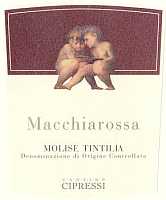
|
|
Molise Tintilia Macchiarossa 2004 |
|
| Cantine Cipressi (Molise, Italy) | |
| Grapes: Tintilia | |
| Price: € 16.00 | Score: |
| Molise Tintilia Macchiarossa shows a brilliant ruby red color and nuances of garnet red, little transparency. The nose denotes intense, clean, pleasing and refined aromas which start with hints of black cherry and plum followed by aromas of blueberry, blackberry, cyclamen, violet, black pepper, vanilla and carob. The mouth has good correspondence to the nose, a tannic attack and pleasing roundness, however balanced by alcohol, good body, intense flavors. The finish is persistent with flavors of black cherry and plum. Molise Tintilia Macchiarossa ages for about 12 months in cask. | |
| Food Match: Roasted meat, Stewed and braised meat, Hard cheese | |
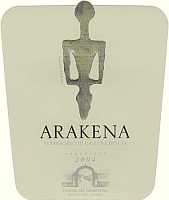
|
|
Vermentino di Gallura Superiore Arakena 2005 |
|
| Cantina del Vermentino (Sardinia, Italy) | |
| Grapes: Vermentino | |
| Price: € 18.00 | Score: |
| Vermentino di Gallura Superiore Arakena shows a pale straw yellow color and nuances of greenish yellow, very transparent. The nose reveals intense, clean, pleasing and refined aromas that start with hints of pear, apple and pineapple followed by aromas of almond, hawthorn, peach, broom, rosemary, plum and vanilla. The mouth has good correspondence to the nose, a crisp attack and however balanced by alcohol, good body, intense flavors. The finish is persistent with flavors of apple, plum and pineapple. This wine ferments in cask. | |
| Food Match: Pasta and risotto with fish and crustaceans, Broiled fish, Stewed fish | |
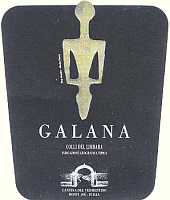
|
|
Galana 2000 |
|
| Cantina del Vermentino (Sardinia, Italy) | |
| Grapes: Cabernet Sauvignon (20%), Sangiovese (20%), Carignano (20%), Cagnulari (20%), Bovale (20%) | |
| Price: € 18.00 | Score: |
| Galana shows a brilliant ruby red color and nuances of garnet red, moderate transparency. The nose denotes intense, clean, pleasing and refined aromas that start with hints of black cherry, plum and geranium followed by aromas of raspberry, violet, vanilla, tobacco, pink pepper, menthol and cinnamon. The mouth has good correspondence to the nose, a tannic attack and pleasing roundness, however balanced by alcohol, good body, intense flavors. The finish is persistent with flavors of black cherry, plum and raspberry. Galana ages for 13 months in cask followed by at least 10-15 months of aging in bottle. | |
| Food Match: Roasted meat, Stewed and braised meat, Hard cheese | |
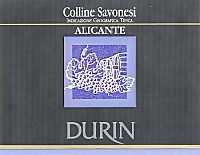
|
|
Alicante 2004 |
|
| Durin (Liguria, Italy) | |
| Grapes: Alicante | |
| Price: € 13.50 | Score: |
| This Alicante shows an intense ruby red color and nuances of ruby red, little transparency. The nose denotes intense,clean, pleasing and refined aromas that start with hints of black cherry and plum followed by aromas of rose, blackberry, vanilla, carob and menthol. The mouth has good correspondence to the nose, a tannic attack and however balanced by alcohol, good body, intense flavors. The finish is persistent with flavors of black cherry and plum. This wine ages for 10-12 months in barrique followed by 6 months of aging in bottle. | |
| Food Match: Roasted meat, Stewed meat, Hard cheese | |
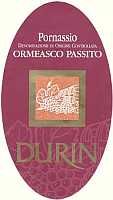
|
|
Pornassio Ormeasco Passito 2005 |
|
| Durin (Liguria, Italy) | |
| Grapes: Ormeasco | |
| Price: € 15.00 - 0.375l | Score: |
| The wine shows a brilliant ruby red color and nuances of garnet red, moderate transparency. The nose denotes intense, clean, pleasing and refined aromas that start with hints of strawberry, cherry and raspberry followed by aromas of rose, plum, dried violet, vanilla and cinnamon. The mouth has good correspondence to the nose, a sweet and slightly tannic attack, however balanced by alcohol, good body, intense flavors, agreeable. The finish is persistent with flavors of strawberry, cherry and plum. Pornassio Ormeasco Passito ages in small oak barrels. | |
| Food Match: Fruit tarts, Confectionery | |
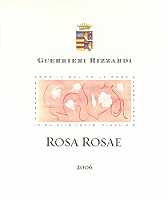
|
|
Rosa Rosae 2006 |
|
| Guerrieri Rizzardi (Veneto, Italy) | |
| Grapes: Corvina (65%), Rondinella (20%), Sangiovese (10%), Marcobona (5%) | |
| Price: € 9.80 | Score: |
| Rosa Rosae shows a brilliant onion skin pink color and nuances of pale pink, transparent. The nose reveals intense, clean, pleasing and refined aromas that start with hints of cherry, raspberry and strawberry followed by aromas of cyclamen, peach, rose and plum. The mouth has good correspondence to the nose, a crisp attack and however balanced by alcohol, good body, intense flavors. The finish is persistent with flavors of cherry, raspberry and strawberry. Rosa Rosae ages for 3 months in steel and cement tanks. | |
| Food Match: Stuffed pasta, Roasted fish, Fish soups, Sauteed white meat | |
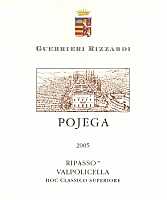
|
|
Valpolicella Classico Superiore Ripasso Pojega 2005 |
|
| Guerrieri Rizzardi (Veneto, Italy) | |
| Grapes: Corvina, Corvinone (85%), Rindonella, Molinara (15%) | |
| Price: € 9.80 | Score: |
| This wine shows a brilliant ruby red color and nuances of ruby red, moderate transparency. The nose denotes intense, clean, pleasing and refined aromas that start with hints of plum, black cherry and blackberry followed by aromas of raspberry, violet, vanilla and pink pepper. The mouth has good correspondence to the nose, a tannic attack and however balanced by alcohol, good body, intense flavors. The finish is persistent with flavors of black cherry and plum. Valpolicella Classico Superiore Ripasso Pojega ages for at least 12 months in cask. | |
| Food Match: Roasted meat, Stewed and braised meat, Hard cheese | |
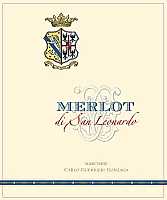
|
|
Merlot di San Leonardo 2004 |
|
| Tenuta San Leonardo (Trentino, Italy) | |
| Grapes: Merlot | |
| Price: € 14.00 | Score: |
| Merlot di San Leonardo shows an intense ruby red color and nuances of garnet red, little transparency. The nose denotes intense, clean, pleasing and refined aromas which start with hints of black cherry, plum and black currant followed by aromas of blueberry, mace, vanilla and eucalyptus. The mouth has good correspondence to the nose, a slightly tannic attack and pleasing roundness, however balanced by alcohol, good body, intense flavors. The finish is persistent with flavors of black cherry, plum and black currant. This Merlot ages for 18 months in cask followed by at least 4 months of aging in bottle. | |
| Food Match: Stuffed pasta, Sauteed meat with mushrooms, Broiled meat and barbecue | |
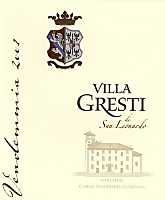
|
|
Villa Gresti 2003 |
|
| Tenuta San Leonardo (Trentino, Italy) | |
| Grapes: Merlot (90%), Carmenère (10%) | |
| Price: € 33.00 | Score: |
| Villa Gresti shows an intense ruby red color and nuances of garnet red, little transparency. The nose reveals intense, clean, pleasing, refined and elegant aromas which start with hints of black currant, plum and black cherry followed by aromas of blueberry, vanilla, chocolate, greenbeans, bell pepper, licorice, tobacco, chocolate, pink pepper and eucalyptus. The mouth has excellent correspondence to the nose, a tannic attack and pleasing roundness, however well balanced by alcohol, full body, intense flavors. The finish is very persistent with long flavors of black cherry, black currant and black cherry. A well made wine. Villa Gresti ages for 12-14 months in barrique followed by 12 months of aging in bottle. | |
| Food Match: Game, Roasted meat, Stewed and braised meat, Hard cheese | |
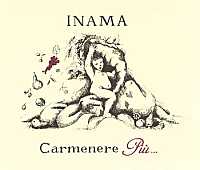
|
|
Carmenere Più 2005 |
|
| Inama (Veneto, Italy) | |
| Grapes: Carmenère (60%), Merlot (30%), Raboso Veronese (10%) | |
| Price: € 13.00 | Score: |
| Carmenere Più shows an intense ruby red color and nuances of ruby red, little transparency. The nose reveals intense, clean, pleasing and refined aromas which start with hints of black cherry, plum and black currant followed by aromas of blueberry, bell pepper, vanilla, violet, cocoa and menthol. The mouth has good correspondence to the nose, a tannic attack and however balanced by alcohol, good body, intense flavors. The finish is persistent with flavors of black cherry, plum and black currant. Carmenere Più ages for 12 months in barrique. | |
| Food Match: Roasted meat, Broiled meat and barbecue, Stewed meat | |
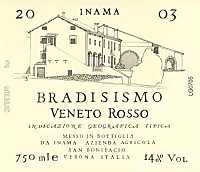
|
|
Bradisismo 2003 |
|
| Inama (Veneto, Italy) | |
| Grapes: Cabernet Sauvignon (70%), Carmenère (20%), Merlot (10%) | |
| Price: € 28.00 | Score: |
| Bradisismo shows a deep ruby red color and nuances of garnet red, little transparency. The nose reveals intense, clean, pleasing, refined and elegant aromas that start with hints of black cherry, plum and black currant followed by aromas of blackberry, violet, bell pepper, tobacco, licorice, cocoa, cinnamon, mace and eucalyptus. The mouth has excellent correspondence to the nose, a tannic attack and however balanced by alcohol, full body, intense flavors, pleasing roundness. The finish is very persistent with long flavors of black currant, black cherry and plum. A well made wine. Bradisismo ages for 15 months in barrique. | |
| Food Match: Game, Roasted meat, Braised and stewed meat, Hard cheese | |
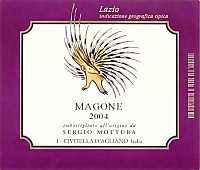
|
|
Magone 2004 |
|
| Sergio Mottura (Latium, Italy) | |
| Grapes: Pinot Noir | |
| Price: € 18.00 | Score: |
| Magone shows an intense ruby red color and nuances of ruby red, moderate transparency. The nose denotes intense, clean and pleasing aromas that start with hints of cherry and plum followed by aromas of raspberry, blueberry, cyclamen and cinnamon. The mouth has good correspondence to the nose, a slightly tannic attack and however balanced by alcohol, good body, intense flavors. The finish is persistent with flavors of plum and cherry. Magone ages for 12 months in cask followed by 6 months of aging in bottle. | |
| Food Match: Stuffed pasta, Stewed meat, Roasted meat | |
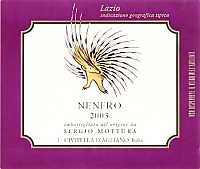
|
|
Nenfro 2003 |
|
| Sergio Mottura (Latium, Italy) | |
| Grapes: Merlot (60%), Montepulciano (40%) | |
| Price: € 16.70 | Score: |
| Nenfro shows a brilliant ruby red color and nuances of garnet red, little transparency. The nose reveals intense, clean, pleasing and refined aromas that start with hints of black cherry, plum and black currant followed by aromas of blueberry, violet, vanilla, tobacco, chocolate and mace. The mouth has good correspondence to the nose, a tannic attack and however balance by alcohol, good body, intense flavors, pleasing roundness. The finish is persistent with flavors of black cherry and plum. Nenfro ages for 12 months in barrique followed by 12 months of aging in bottle. | |
| Food Match: Roasted meat, Stewed and braised meat, Hard cheese | |
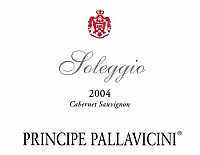
|
|
Soleggio 2004 |
|
| Principe Pallavicini (Latium, Italy) | |
| Grapes: Cabernet Sauvignon | |
| Price: € 10.80 | Score: |
| Soleggio shows an intense ruby red color and nuances of ruby red, little transparency. The nose reveals intense, clean, pleasing and refined aromas which start with hints of black cherry and blueberry followed by aromas of black currant, plum, violet, vanilla and carob. The mouth has good correspondence to the nose, a tannic attack and however balanced by alcohol, good body, intense flavors. The finish is persistent with flavors of black cherry and blueberry. Soleggio ages for 12 months in barrique. | |
| Food Match: Stewed meat with mushrooms, Broiled meat and barbecue, Roasted meat | |

|
|
Moroello 2004 |
|
| Principe Pallavicini (Latium, Italy) | |
| Grapes: Sangiovese Grosso, Merlot | |
| Price: € 19.80 | Score: |
| This wine shows an intense ruby red color and nuances of ruby red, little transparency. The nose denotes intense, clean, pleasing and refined aromas that start with hints of black cherry, plum and black currant followed by aromas of blueberry, cinnamon, bell pepper, violet, tobacco, vanilla, chocolate and menthol. The mouth has good correspondence to the nose, a tannic attack and however balanced by alcohol, good body, intense flavors. The finish is persistent with flavors of black cherry, plum and black currant. Moroello ages in cask. | |
| Food Match: Roasted meat, Braised and stewed meat, Hard cheese | |
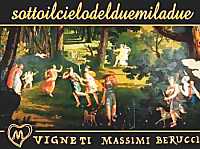
|
|
Sottoilcielodelduemiladue 2002 |
|
| Vigneti Massimi Berucci (Latium, Italy) | |
| Grapes: Cesanese d'Affile (70%), Aglianico (30%) | |
| Price: € 10.60 | Score: |
| This wine shows an intense ruby red color and nuances of garnet red, little transparency. The nose denotes intense, clean, pleasing and refined aromas that start with hints of plum and blueberry followed by aromas of black cherry, dried violet, vanilla, tobacco, carob and menthol. The mouth has good correspondence to the nose, a tannic attack and however balanced by alcohol, good body, intense flavors. The finish is persistent with flavors of black cherry and plum. This wine ages in cask. | |
| Food Match: Cold cuts, Stewed meat with mushrooms, Roasted meat | |

|
|
Cesanese del Piglio Vigne Nuove 2003 |
|
| Vigneti Massimi Berucci (Latium, Italy) | |
| Grapes: Cesanese d'Affile | |
| Price: € 18.00 | Score: |
| Cesanese del Piglio Vigne Nuove shows an intense ruby red color and nuances of garnet red, little transparency. The nose reveals intense, clean, pleasing and refined aromas that start with hints of black cherry and blueberry followed by aromas of blackberry, plum, violet, vanilla, tobacco, cinnamon and carob. The mouth has good correspondence to the nose, a tannic attack and pleasing roundness, however balanced by alcohol, good body, intense flavors. The finish is persistent with flavors of blueberry and plum. Cesanese del Piglio Vigne Nuove ages in cask for 12 months followed by 8 months of aging in bottle. | |
| Food Match: Roasted meat, Stewed and braised meat, Hard cheese | |
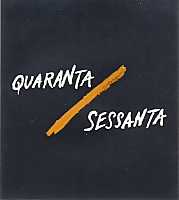
|
|
Quaranta/Sessanta 2005 |
|
| L'Olivella (Latium, Italy) | |
| Grapes: Syrah (40%), Cesanese (60%) | |
| Price: € 6.90 | Score: |
| The wine shows a brilliant ruby red color and nuances of ruby red, moderate transparency. The nose denotes intense, clean and pleasing aromas which start with hints of black cherry, plum and blackberry followed by aromas of raspberry, strawberry, black pepper and violet. The mouth has good correspondence to the nose, a tannic attack and however balanced by alcohol, good body, intense flavors. The finish is persistent with flavors of black cherry and plum. | |
| Food Match: Stuffed pasta with meat, Stewed meat, Broiled meat and barbecue | |
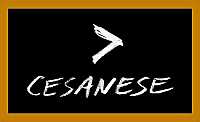
|
|
Cesanese Maggiore 2003 |
|
| L'Olivella (Latium, Italy) | |
| Grapes: Cesanese | |
| Price: € 16.20 | Score: |
| Cesanese Maggiore shows an intense ruby red color and nuances of garnet red, little transparency. The nose denotes intense, clean, pleasing and refined aromas that start with hints of black cherry, plum and blueberry followed by aromas of violet, tobacco, vanilla, licorice, chocolate, mace and menthol. The mouth has good correspondence to the nose, a tannic attack and however balanced by alcohol, good body, intense flavors, pleasing roundness. The finish is persistent with flavors of black cherry, plum and blueberry. Cesanese Maggiore ages for 12 months in cask. | |
| Food Match: Roasted meat, Stewed meat with mushrooms, Hard cheese | |
FlorioEstablished in 1832 by Vincenzo Florio, the prestigious winery of Marsala is still today the protagonist of important pages of history and great wines, such as the new Marsala Superiore Riserva Donna Franca |
|
The history of Marsala is among the most amazing ones known today, not only because it is a wine discovered as an accidental consequence by its “inventor”, but also for the fact it is one of the greatest Italian wines. In past times, Marsala has been capable of being compared and winning the challenge against the wines considered at those times the best ones in the world. After up and downs, today Marsala is living a new and shining life, where quality is finally one of the main characteristics of this wine, while leaving back - and hopefully forever - the errors and mistakes done by many producers for too many years. In the course of the last twenty years, producers made considerable efforts in order to finally give back to Marsala the dignity this great wine is worth of, as well as paying higher attention on the vinification practices and on quality. In fact, today we can say the famous Victory Wine, very appreciated by admiral Horatio Nelson, is finally back.
The history of Marsala, despite it is now very popular, it is always worth to remember, a history having among its protagonists Vincenzo Florio, the first Italian to establish a winery dedicated to the production of this wine. History tells in 1773, because of a storm, the English merchant John Woodhouse was forced to land to the port of Marsala, instead to the one of Mazara del Vallo, where he was sailing for his businesses. When he set his foot on land, he entered a tavern in search of relief and relax and here he had the chance to try the local wine. In fact they served him some perpetuum, the wine traditionally produced at Marsala. Perpetuum - or perpetuo (literally, perpetual) - was produced by filling the cask with the wine of the latest harvesting and then drawn off according to need, the cask was then refilled - which contained some of the wine of all the preceding vintages - with new wine. A wine therefore undergoing a natural oxidation process according to its progressive emptying and taking “new life” with the adding of the wine from the new vintage. Woodhouse found that wine particularly good, also because it reminded him the famous wines of Madeira and Jerez, being very appreciated in his homeland. Being a talented merchant, he decided to ship some of that wine to England while hoping to start a flourishing commerce. As Woodhouse knew of the adverse condition the wine is usually suffering in the holds of ships, he decided to add some brandy to each cask in order to ensure a better keeping. Then Woodhouse returned to England with his precious load and, when he arrived, he realized the reinforced wine was become better than when he left Sicily: it was a striking success. Woodhouse returned back to Sicily and established his winery for the production of wine: in few years his Marsala wine became successful in England and it soon become the wine mainly consumed in the ships of Her Britannic Majesty's fleet. It is said Horatio Nelson - who particularly appreciated Marsala - used to celebrate the victories in his battles with this wine, and for this reason it was called victory wine.
At the beginning of the 1800s, two Englishmen, encouraged by the success of Woodhouse, entered the history of Marsala: Benjamin Ingham and his nephew John Whitaker who established Ingham winery near the one of Woodhouse. Thanks to their work, the quality and the production of Marsala developed greatly. It will be in 1832 the first Italian will enter the scene of Marsala. It was Vincenzo Florio - skilled merchant from Bagnara Calabra, at those times successful merchant of spices and descendant from one of the most prestigious and rich Italian family of that time - who decided to establish his winery between the ones of Woodhouse and Ingham. The contribution of Vincenzo Florio for the development and the image of Marsala was remarkable. Thanks to this, Marsala soon changed its image and from wine destined to the sailors of the English fleet, it became a wine appreciated and looked for in the noble courts all over Europe. The skill and the success of the Florio family and their wines seems to be unstoppable and in 1904 they establish, together with other entrepreneurs of Marsala, S.A.V.I (Società Anonima Vinicola Italiana, Anonymous Italian Wine making Society) which in few years acquires the wineries of Woodhouse and Ingham-Whitaker. In 1924, because of the lack of male inheritors, the Florio family decides to sell the winery of Marsala to Cinzano, another important family in the history of Italian wine. In the course of the last world war, because of the bombing raids of the allied aviation, Florio wineries were severely damaged, and the restoration of the winery required a very long time, and only in 1984 the restoration will be completed. In January 1998 the control of Florio winery passes to ILLVA Saronno Holding, which in 1987 already owned the 50% of the firm's shares, therefore beginning a new and important chapter of this historical winery. Important and fundamental changes in the production and commercial management are in fact introduced, by putting wine maker Carlo Casavecchia in charge of the production management. Thanks to his competence and skill, Carlo Casavecchia will give a fundamental contribution to the rebirth of Marsala Florio - as well as to the qualitative image of Marsala in general - by adopting scrupulous selections in every phase of production and by introducing productive criteria of very high quality. The result of the Carlo Casavecchia's and Florio's work are now indisputable: Marsala is today living again the glorious events of its history and the Florio name is everywhere in the world the synonym of quality Marsala. The current production of Florio Winery is divided between excellent Marsala and sweet wines, such as Malvasia delle Lipari, Passito di Pantelleria, Grecale and Morsi di Luce, an excellent wine made from Moscato d'Alessandria, known in Sicily as Zibibbo. Florio is currently producing five different styles of Marsala: Marsala Superiore “Vecchioflorio” - an excellent value wine - Marsala Superiore Riserva Targa, Marsala Vergine Terre Arse, the excellent Marsala Vergine Baglio Florio and, the last born, Marsala Superiore Riserva Donna Franca, a tribute to Donna Franca Florio, a prominent figure of belle epoque, as well as woman of refined class and beauty. Marsala Superiore Riserva Donna Franca is in fact the last magic created by wine maker Carlo Casavecchia, result of years of researches and studies, which led to the creation of this charming and smooth wine which will certainly be capable of satisfying the sense of the most exacting enthusiasts. Donna Franca is in fact a Marsala Superiore Riserva of indisputable class and elegance, a continuous discovery made of aromas and emotions, the confirmation of the quality Marsala Florio has been capable to prove in the course of its long and prestigious history.
|
||||||||||||||||||||
|
Score legend Prices are to be considered as indicative. Prices may vary according to the country or the shop where wines are bought |
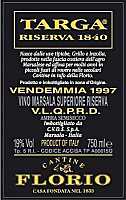
|
|
Marsala Superiore Riserva Targa Riserva 1840 1997 |
|
| Florio (Sicily, Italy) | |
| Grapes: Grillo | |
| Price: € 11.00 | Score: |
| Marsala Superiore Riserva Targa Riserva 1840 shows a deep amber yellow color and nuances of amber yellow, transparent. The nose denotes intense, clean, pleasing and refined aromas that start with hints of fig jam, caramel and almond followed by aromas of rancho, apricot jam, vanilla, honey, orange marmalade, date, licorice and leather. The mouth has good correspondence to the nose, an alcoholic and sweet attack, however balanced, full body, intense flavors, pleasing roundness. The finish is persistent with flavors of fig jam, date and almond. Marsala Superiore Riserva Targa Riserva 1840 ages for at least 6 years in cask followed by at least 6 months of aging in bottle. | |
| Food Match: Confectionery, Almond tarts, Hard and piquant cheese | |
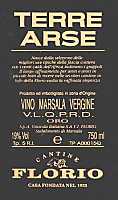
|
|
Marsala Vergine Terre Arse 1998 |
|
| Florio (Sicily, Italy) | |
| Grapes: Grillo | |
| Price: € 15.50 | Score: |
| Marsala Vergine Terre Arse shows a brilliant amber yellow color and nuances of amber yellow, very transparent. The nose reveals intense, clean, pleasing and refined aromas that start with hints of rancho, dried fig and almond followed by aromas of walnut husk, vanilla, citrus fruit peel, nail polish, raisin, honey, date and licorice. The mouth has good correspondence to the nose, an alcoholic attack and pleasing roundness, however balanced, full body, intense flavors. The finish is persistent with flavors of dried fig, almond and honey. Marsala Vergine Terre Arse ages for at least 8 years in cask followed by at least 6 months of aging in bottle. | |
| Food Match: Smoked fish, Roasted meat, Hard cheese | |
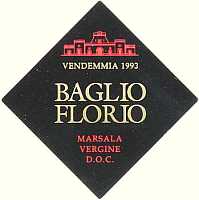
|
|
Marsala Vergine Baglio Florio 1993 |
|
| Florio (Sicily, Italy) | |
| Grapes: Grillo | |
| Price: € 18.00 - 50cl | Score: |
| Marsala Vergine Baglio Florio shows a brilliant amber yellow color and nuances of amber yellow, very transparent. The nose reveals intense, clean, pleasing, refined and elegant aromas which start with hints of rancho, dried fig and almond followed by aromas of walnut husk, honey, vanilla, licorice, apricot jam, nail polish, tobacco, raisin, citrus fruit peel and leather. The mouth has excellent correspondence to the nose, an alcoholic attack and pleasing roundness, however balanced, full body, intense flavors. The finish is very persistent with long flavors of dried fig, almond and honey. A well made wine. Marsala Vergine Baglio Florio ages for more than 10 years in cask followed by at least one year of aging in bottle. | |
| Food Match: Smoked fish, Roasted meat, Hard cheese | |
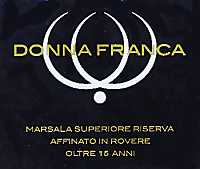
|
|
Marsala Superiore Riserva Semisecco Ambra Donna Franca |
|
| Florio (Sicily, Italy) | |
| Grapes: Grillo | |
| Price: € 25.00 - 50cl | Score: |
| Marsala Superiore Riserva Donna Franca shows an intense amber yellow color and nuances of amber yellow, transparent. The nose reveals intense, clean, pleasing, refined and elegant aromas that start with hints of dried apricot, dried fig, date and almond followed by aromas of caramel, vanilla, candied fruit, raisin, rhubarb, nail polish, citrus fruits peel, honey and licorice. The mouth has excellent correspondence to the nose, an alcoholic and sweet attack, however balanced, full body, intense flavors, pleasing roundness. The finish is very persistent with long flavors of dried apricot, dried fig, honey and almond. A well made wine. Marsala Superiore Riserva Donna Franca is the evolution of “Riserva Aegusa”, selection of the best Florio's Marsala created around the end of the 1800s. Ages for at least 15 years in cask followed by at least 6 months of aging in bottle. | |
| Food Match: Dried fruit tarts, Chocolate, Hard and piquant cheese | |
| Cantine Florio - Via Vincenzo Florio, 1 - 91025 Marsala, Trapani (italy) - Tel. +39 923 781111 Fax: +39 923 982380 - Winemaker: Carlo Casavecchia - Established: 1833 - Production: 3.500.000 bottles - E-Mail: info@cantineflorio.it - WEB: www.cantineflorio.it |
Vin Santo Avignonesi 1996At Fattoria di Capezzine was held the ceremony of the opening of caratelli containing the monumental Avignonesi's Vin Santo and Vin Santo Occhio di Pernice |
|
The last May 12th, 2007 we had the pleasure to take part to the ceremony of the opening of caratelli containing Avignonesi's Vin Santo which, after a patient waiting of 10 years spent inside the vinsantaia - a sort of wine cathedral - it is given back to the present time in all of its uniqueness and extraordinary magnificence. The day started in the best possible way, kissed by the sun of a beautiful springtime day, with our arrival at 10:00 AM at Fattoria di Capezzine in Valiano di Montepulciano. Here it is in fact located the suggestive vinsantaia where are arranged hundreds of caratelli - 50 liters small barrels neatly divided according to vintage - in which are kept two of the most extraordinary wines of Italy and of the world. Avignonesi's Vin Santo and Vin Santo Occhio di Pernice are in fact the only two wines to have been awarded with the excellent score of DiWineTaste's Five Diamonds and One Star in the course of the five years of our editorial activity and wine review.
A suggestive event, one of those days which can be hardly forgotten, a ceremony where the absolute protagonist is always the same - the great Avignonesi's Vin Santo - a wine that, for its characteristics and qualities, could be defined as a wine came down from the Olympus, a special gift from Bacchus and Dionysus to us common mortals. When we arrive at Fattoria di Capezzine, we are welcomed by Laura Paolucci, who worked on the organization of the event. The ceremony begins with the welcome of Alberto Falvo - managing director of Avignonesi - and with the usual kindness and hospitality distinguishing the Falvo family. Before proceeding with the ceremony of the opening of caratelli, Alberto Falvo talks about the history of Avignonesi's Vin Santo and its production: a very interesting witness unfold with no secrets, and in particular, a passionate witness of what Vin Santo represents for the Falvo family and Avignonesi. Alberto Falvo explains to the participants the grapes - Grechetto, Trebbiano Toscano and Malvasia for Vin Santo, Prugnolo Gentile for Vin Santo Occhio di Pernice - after having been dried on mats, are crushed and the concentrated must is transferred into caratelli, the traditional small 50 liters barrels. Caratelli are filled for about 45 liters, leaving a proper empty space necessary to the very slow fermentation - which can also take three years - and to the air which will contribute, together with time, to the evolution of this extraordinary wine. Caratelli are closed with a cork wrapped in a piece of linen fabric and sealed with wax. Caratelli are then committed to the magic of time and allowed to age for ten years. After this time, caratelli are opened, the Vin Santo is drawn off while leaving in the bottom the so called madre (mother), the unique, extraordinary and inimitable patrimony of Vin Santo and which will be used for the new Vin Santo. Alberto Falvo explained from 45-46 liters of every caratello, are obtained, after ten years and because of the effects of natural reduction caused by the pores of the wood, about 28 liters of Vin Santo. Before beginning the ceremony of the opening, we listened to the interesting contribution of Dr. Paolo Trappolini - wine maker of Avignonesi - who talked about technical details concerning this wine. Paolo Trappolini explained, among the many things, the concentration of sugar in the must obtained from the dried grapes is about 600 grams per liter, almost three times the content found in must destined to the production of “common” table wines.
At the end of this interesting introduction, the group moves in front of caratelli containing the precious Vin Santo 1996 and everything is ready for the first hit of hammer which will break the seal of wax of the first caratello. The moment is very suggestive: an almost unreal silence and the eyes staring the hammer which will soon allow the view of the cork, guard and witness of a story began 10 years ago. It is now the turn of the brush cleaning the debris of wax, and a corkscrew is then screwed in the cork which is finally extracted from the caratello. The air suddenly gets full of strong and intense aromas: it is the voice of Vin Santo which in this way greets participants with its return, as if it were impatient to tell everything it saw and met during this long and amazing journey. A siphon is now put into the caratello which will allow the drawing of Vin Santo and which will be seen, for the first time, in all of its magnificence. The operations are supervised by wine maker Paolo Trappolini - who waits with a glass in his hands the spouting of Vin Santo - and cellar master Angiolino Sarcoli, supported by Orazio Capoccia and Piergiorgio Tacconi. The long wait is finally rewarded and the Vin Santo flows slowly and thick from the pipe: Paolo Trappolini fills a glass, watch it, smell it and finally tastes it while being observed by everyone, all being waiting for his response. The result is clear when the face of Paolo Trappolini is enlightened by a huge smile: Vin Santo Avignonesi 1996 is born. The glass is passed from hand to hand, everyone ideally united by the extraordinary magnificence of this suggestive moment expressed in the aromas and flavors coming out from the same glass, as to celebrate a sacred rite which everyone will certainly treasure in their memories. The ceremony continues with the opening of the second caratello: the same operations are repeated, same silence, same waiting, same magic with the air full of new aromas, a new glass filled with a new nectar to delight senses and emotions of the few participants. Everything is repeated for the remaining caratelli - twelve in total - and every time it is a new and amazing magic. According to a sensorial point of view, the differences found on any Vin Santo are impressive, every caratello contains a Vin Santo with its own color, aromas and flavors. Despite every caratello confirms the magnificence and the uniqueness of Avignonesi's Vin Santo, each of them - as it can be easily imagined - contains a wine with a proper personality and class, all of them being great although different. It is extraordinary to think all this is the result of conditions and factors which could give a nightmare to every wine maker during the production of every other wine, not for Avignonesi's Vin Santo. Oxidation, total absence of tasting and analyses during the whole time of production, fermentation which starts and stops all the time and according to the course of seasons and continuous variations of temperature. Everything committed to time and the wisdom of being capable of waiting great things to happen with no hurry, something which is widely rewarded by the magic of the ceremony of the opening of caratelli and to the renewed certainty of giving birth to something unique and unrepeatable. Welcome Avignonesi's Vin Santo and Vin Santo Occhio di Pernice 1996!
|
||||||||||||||||||||
News |
|
In this section are published news and information about events concerning the world of wine and food. Whoever is interested in publishing this kind of information can send us a mail to our address.
|
Making Wine: AgingAging is a fundamental process allowing the production of a wine with more rich and complex organoleptic qualities, a process depending on type of grapes and wine |
|
Wine, according to a technical point of view, is ready at the end of alcoholic fermentation. A wine which is still immature, rich of young and unripe qualities, however considered a wine according to every point of view. Sugar, because of the effects of yeast, is now transformed into alcohol, aromas - because of fermentation - are now developed, so far from the ones of grape and of must. Whether according to a technical point of view the wine is now ready, the same cannot be said according to an organoleptic point of view. Soon after fermentation, wine is in fact hazy, with many solid parts in suspension, acidity is pretty evident - a quality which is however welcome in most of white wines - and in red wines astringency of tannins is pretty aggressive. The “cure” to all of these young qualities is represented by time which, together with proper wine making techniques, will give a more mature wine, with agreeable and pleasing organoleptic qualities.
The phase between alcoholic fermentation and bottling is called aging, period during which wine develops and changes, also thanks to the fundamental role of oxygen, it becomes more stable while losing the typical young character. Indeed, the aging of wine continues - although by means of different ways and natural phenomena - inside the bottle. Bottle aging is in fact very important and allow the wine to get improved by “refining” all the qualities found in a ready wine. Despite aging is a fundamental phase for every type of wine, indeed its practice and duration varies according to many factors, such as the type of grape, vinification technique and type of wine. Aging is then part of the “natural” biological cycle of wine, however different for each of them, by following an evolution beginning with youth, therefore developing towards the apex of aging - that is when the wine will have its best organoleptic characteristics - and then moving to its decline, a period during which the wine goes towards its inexorable end.
|
||||||||
|
The choice of the container to be used for the aging is done according to the type of wine to be made, the quality of grapes and the wine making techniques. Every wine is different from any other, therefore the practice of aging will change according to the wanted result. In most of the cases, whenever it is thought about the aging of wine, the type of container commonly associated to this process is the cask, however this is not the best choice in every case. Every container has in fact proper qualities and characteristics making it suitable for the aging of specific wines and therefore unsuited for the aging of others. It was already mentioned oxygen plays a fundamental role in the aging of wine, however this is not the only factor contributing to the development of the entire aging process. Other factors influencing aging of wine include the type of container, temperature, humidity, light and keeping practices, such as topping ups and rackings, as well as - of course - specific qualities of wine. Every type of container offers advantages and disadvantages for the aging of specific wines, moreover it must be considered containers belonging to the same type are different one from another, with proper characteristics and qualities. For example, if we consider the cask, belonging to the category of wood containers, the definition is pretty generic as every cask is different from another because of volume, type of wood and thickness of staves. All of these characteristics directly influence the aging of wine, therefore it will be chosen according to the wanted result. For example, the type of wood, volume and thickness of staves directly influences the quantity of oxygen reaching the inside of the cask from the outside, as well as the passage of internal substances to the outside. Moreover, the type of wood - its area of origin and the type of tree from which it is obtained from - besides having an absolutely proper porosity, gives the wine specific organoleptic qualities, different qualities and quantities of tannins, also determined by the level of toasting with which the wood was processed during the construction of the cask. Of all the types of containers used for the aging of wine, only the ones made of wood play an active role, they give the wine their own organoleptic qualities and allow the participation of oxygen. All the other containers - as they do not have these two qualities - are generically defined as inert, that is made of materials having no capacity of changing the organoleptic qualities of wine, such as stainless steel and glass. The main inert containers are represented by steel tanks, cement and fiberglass vats, demijohns and bottles. If it is true inert containers do not allow the passage of oxygen - of course provided proper keeping conditions are adopted - it should be considered they are however sensitive to temperature, a factor influencing the speed of aging. In case are used glass containers - such as demijohns - another factor should be considered as well, in fact by passing through the glass, it influences the aging and stability of color, in particular in white wines. The case of wood containers is more complex, not only for the fact they allow the passage of oxygen through the pores, but also because they are made of organic material and therefore playing an “active” role. In wood containers - casks, barrels and barriques - also happens the passage of wine, water and alcohol in particular, from the inside to the outside, a phenomenon causing both the concentration and the diminishing of wine and therefore requiring frequent topping ups. As the aging in cask is strictly associated to the quantity of oxygen reaching the inside through the pores, this factor is widely determined by volume, type of wood used for the construction - therefore the grain of wood and stave thickness - as well as temperature. The smaller the volume of the cask, the quicker the aging and the effect of oxidation: wine ages quicker in barrique than in a cask. Casks are made of different types of wood, each of them having absolute proper characteristics, of which the most common types are oak, chestnut and cherry wood.
|
||||
|
The aging of wine is the result of a series of phenomena occurring during a period of time and in which oxygen plays a role of primary importance. In wood containers, oxygen reaches the wine thanks to the porosity of wood, ensuring a flow in extremely reduced quantity although continuous. Oxygen also plays a fundamental role in the aging done in inert containers and, despite the keeping is done in order to avoid any contact with the air, the oxygen however gets in contact with the wine during the operations of racking. The role of oxygen in the evolution of organoleptic qualities of wine also continues at the end of aging, when the wine is finally bottled. In bottles closed with corks it in fact occurs an exchange of oxygen from the outside to the inside of the bottle through the pores of the cork itself. This process is fundamental for red and white wines destined to the aging in bottle, whereas for white wines not suited for aging, the contact with oxygen causes the loss of fresh and fruity organoleptic qualities. The phenomena taking place during the aging of wine are divided into three categories: chemical phenomena, physical phenomena and physical-chemical processes. Chemical phenomena are represented by oxidation and oxyreduction, esterification, condensation and copolymerization; physical phenomena include saturation, precipitation of solid substances, evaporation, loss of carbon dioxide. Physical-chemical processes are mainly about flocculation and sedimentation, indispensable to get a limpid and stable wine. These processes occurs for all the duration of aging - therefore for all the life cycle of wine - including the period of aging in bottle. The velocity and the time required for the development of these phenomena depend on many factors of physical and chemical nature occurring during aging, last but not the least, on the specific qualities of grapes and the type of vinification. For example, in wines produced with Nebbiolo or Sagrantino grapes, aging processes are slower than in the ones occurring in wines produced with Freisa or Grignolino. As the oxygen is the most important factor in the aging of wine, oxidation is therefore the main chemical phenomenon. The bond between wine and oxygen is very strong, not only it is indispensable for the aging, but it also gets rapidly combined to many elements contained in the wine, therefore causing oxidation. Oxygen dissolves in the wine both during the aging in wood containers as well as during the operation of rackings and bottling. Oxidation of wine is a process essentially concerning some components only, such as tartaric acid, alcohol, polyphenolic substances and coloring substances. Tartaric acid - in pure solution - it is not subject of any oxidation, however in presence of iron or copper occurs its oxidation and degradation. Oxidation of tartaric acid is very important for the development of the so called tertiary aromas, that is the aromas developing with aging. Also alcohol, because of the bond with oxygen, get oxidized and produces acetaldehyde, also known as ethanal. More important is the oxidation of polyphenolic and coloring substances. Oxidation of polyphenolic substances - commonly defined as tannins - is something usually happening in red wines only. Oxidation of polyphenolic substances produces a strong diminishing of wine's harshness and its astringency. Oxidation of polyphenolic substances is very important for the improvement of organoleptic agreeability of a red wine, in particular wines produced with grapes rich in tannins, such as Nebbiolo, Cabernet Sauvignon and Sagrantino. Besides oxidation, with time polyphenolic substances change as well, they aggregate and form bigger molecules, giving origin to polymers. This transformation makes the astringency less aggressive, in other words, the wine gets smoother and more pleasing. With time, these aggregates of polyphenols move to the bottom therefore forming a sediment, a phenomenon which can be sometimes observed in bottle of red wines aged for a long time and produced with grapes rich in polyphenolic and coloring substances. The oxidation of coloring substances is a phenomenon occurring both in white and red wines. In white wines the color gets darker hues of golden yellow, whereas in red wines purple hues are soon replaced by ruby red, then garnet and finally brick red. In white wines the color can also change in consequence of the oxidation of alcohol, with an abundant production of acetaldehyde, causing a strong change in color with golden or amber yellow hues, sometimes developing some faults such as excessive acidity. The result of these phenomena is commonly known as maderization. The development of oxidation is determined by the presence of some factors. High temperatures accelerate oxidation whereas lower temperatures favor the dissolution of oxygen. Some substances found in wine, such as polyphenols, sulfur dioxide and some acid substances, make the oxidation of some wine's components difficult: this explains the slow aging of wines produced with grapes rich in polyphenolic substances. The esterification is another important phenomenon taking place during the aging of wine. Responsible of esterification is the reaction between alcohol and the acids found in wine and which give origin to esters, such as ethyl acetate and ethyl lactate. Only volatile esters influence the aromatic profile of wine, most of the times responsible for unpleasing aromas. During aging it is also observed the precipitation of potassium bitartrate in the form of crystals settling on the bottom. This precipitation produces a diminishing of acidity only and it is mainly observed at the end of wintertime and cold season. Just like in every sedimentation phenomenon taking place in a wine, a racking allows the elimination of potassium bitartrate crystals. Lastly, when the aging is done in wood containers, after some years it is observed a loss of alcohol caused by evaporation. The quantity of lost alcohol essentially depends on the volume of the cask and the grain of wood, however it is generally from 0.2 to 0.3% a year.
|
OnionAmong the most common vegetables, onion is a fundamental ingredient in many cooking in the world, capable of giving taste and finesse to every dish |
|
Onion probably is the most common vegetable in the world, appreciated by men for more than four thousand years. Belonging to the family of Alliaceae, onion - whose scientific name is Allium Cepa - certainly is one of the most used vegetables in cooking. It is believed onion is from Asia, however in case of plants known since immemorial times, it is pretty difficult to find a reliable origin, also for the fact the original plant from which it derives could be extincted, or it could have changed so deeply and became different. By observing the varieties of onion existing today, it can be mainly noticed differences in the shape: single bulb, grouped bulbs, large bulbs, small bulbs and with green sprouts. These differences certainly are of interest for botanists, but also for cooks who need to choose the most suitable type according to every gastronomical recipe. Basically speaking, all the cultivated onions belong to few well distinct species.
Among the many varieties of onions, four of them are particularly common. Allium Cepa - or European onion - with hundreds of different types in shape, color and aroma. To know whether it is an European onion, it is enough to carefully watch the section of a leaf: in case it has a concave surface, it is hollow and flat, then it belongs to the cepa variety. Allium Fistulosum, very common and used in the East, it is the species to which belongs Japanese onion. Fistulosum onions can be recognized by cutting the section of a leaf: the inside is hollow and round. Allium Tuberosum, commonly known as Chinese chive, is very common in China, Japan and in some areas in Northern India. It spontaneously grows in China and in some areas of Himalaya, it looks bigger than chive and has non concave leaves. This variety does not blossom in tempered climates, however in the areas where this variety of onion blossoms, its flowers are used for making salads. Allium Schoenoprasum is the only variety spontaneously growing both in America and in Europe. Thanks to its high capacity of adaptation to different climates, such as alpine climates, this variety shows remarkable variations. Its cultivation seems to date back to the Middle Age, and it is very used by the cheese industry to aromatize cheese and in cooking to aromatize soups, omelettes and other dishes.
|
||||||||
|
It seems the onion is from Asia, more likely from Persia. It was known and appreciated by Egyptians around 3,000 BC, and they depicted it in their tombs and used as a part of the salary for soldiers. In Europe it was introduced by ancient Greeks and Romans knew and appreciated its many qualities. Pliny the Elder - Roman scientist, naturalist and historian - described it as a powerful diuretic in case it is consumed raw and laxative when cooked. With time the few species have generated hundreds of varieties, all being different one from another in color, taste, aroma, size and keeping qualities. For a correct use in cooking it is indispensable to recognize it in order to properly cook it, as the aroma and the taste of onion change according to variety, type and duration of cooking. For example, a cut onion left to the air, develops, after some time, an aroma which can be found in kebab, a stale taste, typical of the meat allowed to hang for one night with onions. Expert cooks, in order to keep a cut onion, scald it with some butter: in this way it is possible to keep it in the fridge for one day. Spring onions and shallots are the most suitable varieties to be consumed raw - also mixed with salad - in this sense, the best varieties are the ones belonging to Allium Cepa and the other varieties with small leaves, erroneously called winter onion or Japanese onion. Winter onion, or Japanese onion, is the most used in the East, in particular in China and in Japan, probably coming from Siberia, it can adapt to many types of soil and climate. Japanese onion is more aromatic and digestible than common onion, however it cannot be dried and it must be consumed fresh. White onion is typical in summertime, the color of the bulb is white, sweet and with a delicate taste, it is suited for dishes where it is not necessary any browning, it is used both raw and cooked. In order to make it more digestible, it is enough to keep it for some hours in water and vinegar and replacing the liquid for three times. The variety known as Egyptian onion, is a plant developing three bulbs and a hollow stalk. The taste of bulbs is very pungent, a quality particularly appreciated by many. Yellow onions are typical in autumn and winter times, and also its taste seems to adapt to the season, in fact its characteristic is to have a strong and pronounced taste. Widely used in French cooking, it is an excellent side dish for pork meat. Red onion is a variety typical in wintertime, characterized by a bulb with a red-purple color, whereas the inside shows a white color with red veins. The taste is intense, strong, pronounced, slightly pungent. It is suited for the preparation of warm dishes and in particular boiled meat and soups, it is excellent fried. Scallion is a white onions with a non fully developed bulb and with a long stalk, having a delicate taste. It can also be consumed raw. Lastly, there is another variety, mainly cultivated in Ireland, called onion potato. Today the onion is available in supermarkets also in dried and powdered form, however, despite its use can be considered handy, its taste and aroma cannot compete, in any case, with fresh onion. The typical aroma of onion is caused by sulphurated substances, also responsible for the tear effect. These substances are water soluble and volatile at room temperature, therefore in order to lower the tear effect, onion can be kept in the fridge and washed before cutting. At the moment of purchase, it is always recommended to pay attention on its solidity: the onion must always be well solid and with no green sprouts. Onion is rich in vitamins - in particular vitamin C - and mineral salts. The characteristic taste is caused by the presence of a volatile oil known as allyl sulfur, a substance also responsible for the diuretic effect. Onion has an antiseptic effect on the gastro-intestinal apparatus and respiratory apparatus, lowers the level of glycaemia and can be useful for hypertension. Moreover, it is diuretic, it lowers the level of cholesterol and glucose in blood. It should be remembered many of the beneficial properties of onion are lost during cooking, therefore, for the ones who can tolerate this, it is best to consume it fresh and raw. Its use is not recommended to anyone having problems of hyperacidity or digestion, as it contributes to increase the level of acidity in the stomach, it is also not recommended to anyone suffering from eczema and dermatitis. Onions contain natural antibiotics and, according to some, rubbing the hair with onion juice is useful to prevent baldness. In medicine, the onion is used for the preparation of cicatrizant creams.
|
||||
AquavitaeReview of Grappa, Distillates and Brandy |
|
|
| Distillates are rated according to DiWineTaste's evaluation method. Please see score legend in the "Wines of the Month" section. |
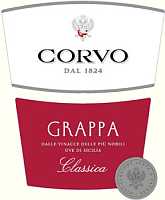
|
|
Grappa Classica Corvo |
|
| Duca di Salaparuta (Sicily, Italy) | |
| (Distiller: Distilleria Trapas) | |
| Raw matter: Pomace of Nero d'Avola, Nerello Mascalese, Pignatello | |
| Price: € 8.80 - 50cl | Score: |
| Grappa Classica Corvo is colorless, limpid and crystalline. The nose denotes intense, clean and pleasing aromas of plum, black cherry, violet, hazelnut and licorice with perceptible alcohol pungency. In the mouth has intense flavors, with perceptible alcohol pungency which tends to dissolve rapidly, good correspondence to the nose, balanced sweetness, pleasing roundness. The finish is persistent with flavors of plum and hazelnut. Alcohol 30%. | |
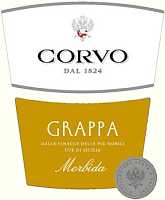
|
|
Grappa Morbida Corvo |
|
| Duca di Salaparuta (Sicily, Italy) | |
| (Distiller: Distilleria Trapas) | |
| Raw matter: Pomace of Inzolia, Grecanico | |
| Price: € 8.80 - 50cl | Score: |
| This grappa shows a pale straw yellow color, limpid and crystalline. The nose denotes intense, clean, pleasing and refined aromas of licorice, chocolate, vanilla, honey, pear and plum with almost imperceptible alcohol pungency. In the mouth has intense flavors, perceptible alcohol pungency which tends to dissolve rapidly, good correspondence to the nose, pleasing roundness. The finish is persistent with flavors of plum and honey. Alcohol 38%. | |
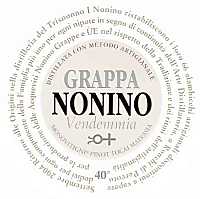
|
|
Grappa Nonino Vendemmia 2006 |
|
| Nonino (Friuli Venezia Giulia, Italy) | |
| Raw matter: Pomace of Pinot, Tocai and Malvasia | |
| Price: € 14.90 - 70cl | Score: |
| This grappa is colorless, limpid and crystalline. The nose reveals intense, clean, pleasing and refined aromas of raspberry, plum, praline, hazelnut, pear, wistaria and apple with almost imperceptible alcohol pungency. In the mouth has intense flavors, with perceptible alcohol pungency which tends to dissolve rapidly, very good correspondence to the nose, balanced sweetness, pleasing roundness. The finish is very persistent with long flavors of pear, plum and raspberry. Grappa Nonino Vendemmia is produced with the discontinuous method in steam operated alembic stills. Alcohol 40%. | |
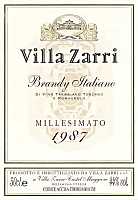
|
|
Brandy Italiano Millesimato 1987 18 Anni |
|
| Villa Zarri (Emilia Romagna, Italy) | |
| Raw matter: Trebbiano Toscano and Trebbiano Romagnolo wines | |
| Price: € 50.00 - 50cl | Score: |
| This brandy shows a dark amber yellow color, limpid and crystalline. The nose reveals intense, clean, pleasing, refined and elegant aromas of chocolate, tobacco, vanilla, honey, hazelnut, prune, licorice, dried fig, praline, ripe banana and cigar box. In the mouth has intense flavors with perceptible alcohol pungency which tends to dissolve rapidly, very balanced, pleasing roundness, velvety. The finish is very persistent with long flavors of chocolate, honey, hazelnut, prune and licorice. A great brandy distilled in discontinuous “Charentais” alembic still and aged in cask until the moment of bottling. Alcohol 44%. | |
Wine Parade |
|
|
| The best 15 wines according to DiWineTaste's readers. To express your best three wines send us an E-mail or fill in the form available at our WEB site. |
| Rank | Wine, Producer | |
|---|---|---|
| 1 |
| Sagrantino di Montefalco Collepiano 2003, Arnaldo Caprai (Italy) |
| 2 |
| Amarone della Valpolicella Classico Costasera 2001, Masi (Italy) |
| 3 |
| Soave Classico Monte Alto 2004, Ca' Rugate (Italy) |
| 4 |
| Don Antonio 2003, Morgante (Italy) |
| 5 |
| Sforzato di Valtellina Canua 2001, Conti Sertoli Salis (Italy) |
| 6 |
| Nero al Tondo 2001, Ruffino (Italy) |
| 7 |
| Barolo Cannubi Boschis 2001, Sandrone (Italy) |
| 8 |
| Chianti Classico Riserva Novecento 2000, Dievole (Italy) |
| 9 |
| Amarone della Valpolicella Classico 2000, Zenato (Italy) |
| 10 |
| Barolo Bussia 2001, Prunotto (Italy) |
| 11 |
| Mater Matuta 2003, Casale del Giglio (Italy) |
| 12 |
| Wine Obsession 2001, Vignamaggio (Italy) |
| 13 |
| Collio Bianco Col Disôre 2004, Russiz Superiore (Italy) |
| 14 |
| San Leonardo 2001, Tenuta San Leonardo (Italy) |
| 15 |
| Brunello di Montalcino 1999, Castello Banfi (Italy) |
| |||||||
Privacy Policy | |||||||


| Copyright © 2002-2024 Antonello Biancalana, DiWineTaste - All rights reserved |
| All rights reserved under international copyright conventions. No part of this publication and of this WEB site may be
reproduced or utilized in any form or by any means, electronic or mechanical, without permission in writing from DiWineTaste. |